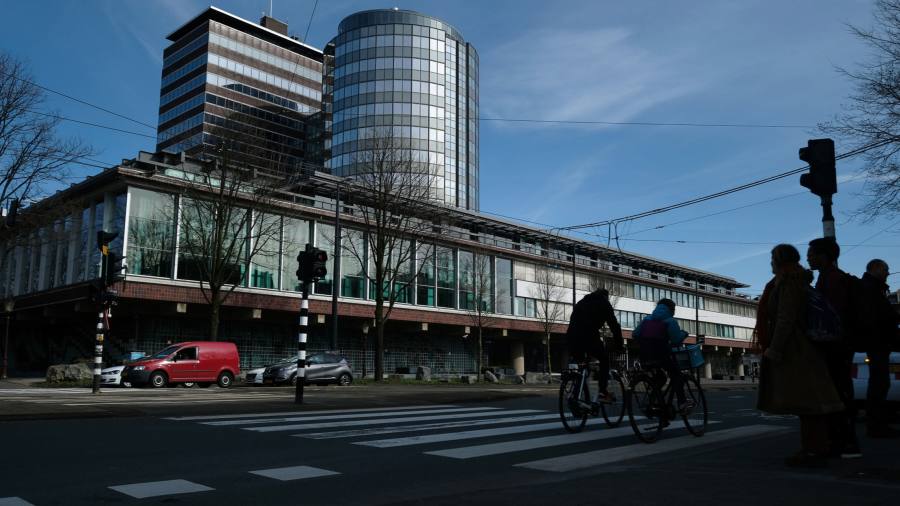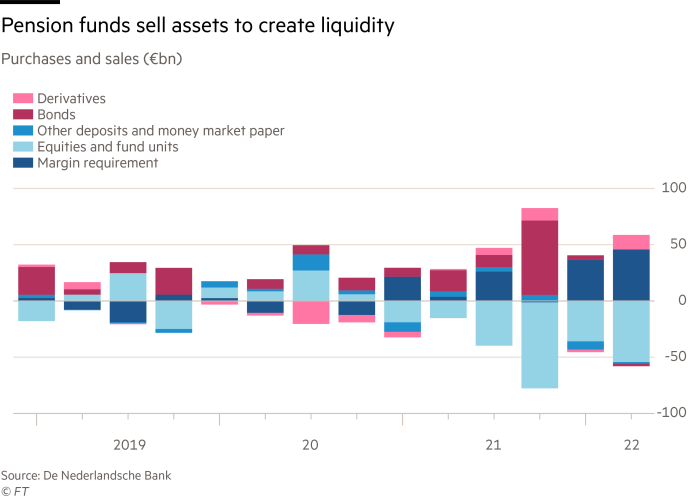
The Dutch central bank is calling on the country’s pension funds to consider boosting holdings of cash and other liquid assets to ensure that they can avoid the turmoil that has hit the UK.
Officials at the De Nederlandsche Bank have asked local retirement funds to check for signs of stress, recommending that they review liquidity rules and report on any need for fire sales of assets, people briefed on the matter told the Financial Times.
The move comes as UK pension schemes have scrambled to sell assets in response to a drop in government debt prices that sparked collateral calls in hedging strategies, following Westminster’s ill-fated “mini” Budget.
So far, the risk to the Netherlands — the EU’s largest pensions market — is deemed to be manageable. But the DNB’s cautious approach underlines how the end of the cheap money era and low interest rates demand new scrutiny of the inner workings of financial systems around the world.
“What we see at the moment is that financial institutions basically are coming to the assessment that the period of low and structurally declining interest rates combined with low volatility is over,” said Lex Hoogduin, a professor at Groningen university and a former board member of the Dutch central bank.
France’s central bank chief also warned in an FT interview this week that the recent turmoil in the UK’s bond market illustrates the “vicious loop” that governments face if they undermine efforts by rate-setters to curb soaring inflation.
The market for workplace pensions in the Netherlands accounts for almost 70 per cent of all eurozone pension fund assets, and the Dutch system shares many similarities with the UK, including large defined-benefit pension liabilities, where schemes commit to pay retirees a fixed amount based on their salary and length of service.
Few other EU countries have such big DB pension systems, with France, Germany, Italy and others relying instead on government pay-as-you-go systems, where retirement benefits are paid solely from contributions by employers and employees.
Many Dutch pensions also use derivatives contracts open for many years to help them match their assets with their liabilities and protect against changes in interest rates. Overall, Dutch pensions accounted for four-fifths of the derivatives of all euro area pension funds, according to EU regulators.
Such contracts are sensitive to daily moves in market prices and need to be backed by margin, a type of insurance, to cover the risk that one side of the trade defaults.
“Some [commercial] advisers are suggesting they should increase their liquidity buffers to cover this risk. But so far there is no panic selling going on, unlike the UK,” said Bas van Zanden, a senior analyst at Dutch lender Rabobank.

Rising yields are generally positive for pension funds, but the volatile moves in global bond markets mean that Dutch funds have also contributed €82bn to margin calls this year to keep their positions open, according to central bank data. The demands have been the largest calls for the past three years.
The derivatives that pensions use are typically tied to the Euribor interbank lending rate, which has been less volatile than market prices for UK gilts. Analysts at Swiss bank UBS said in a recent note that the difference had allowed Dutch schemes “to generate cash rather than engage in a fire-sale”.
Klaas Knot, the Dutch central bank governor, also pointed to several structural reasons why the local market was more stable in an interview with Financieele Dagblad last week.
“Dutch pension funds have diversified their investments more, because they run no exchange rate risk within the eurozone, and the eurozone government bond market is much deeper [than the UK’s],” said Knot. The €1.4tn of assets managed by Dutch pension funds is almost as big as the UK sector, but the market for UK government debt, at £2.1tn, is much smaller than the total outstanding amount of eurozone sovereign debt at €9.7tn.
This means that Dutch pension funds are less likely to have to resort to selling assets fast at low prices, and if they are forced into sales, these are less likely to cause a vicious circle of falling bond prices.
Knot flagged that the liquidity requirements in the Netherlands are tougher than in the UK, which does not have equivalent requirements for pension funds.
The Dutch central bank requires pension funds to file quarterly reports to show if they have enough cash and liquid assets to withstand a 0.5 percentage point rise in Euribor rates over 48 hours or a 1 percentage point rise over three months. Many have extra buffers on top of this, and none have breached these limits in recent weeks.
Liability driven investment (LDI) strategies were used by many British pension funds to hedge 85 per cent of their interest rate risk, according to actuarial consultancy LCP, making them the main source of margin calls.
But LDI strategies are used by only a tenth of Dutch pension funds — and those are mostly smaller schemes. Dutch pension funds also only hedge about 40 per cent of their interest rate risk. In comparison, UK funds’ hedging levels were around twice as high in 2020, according to UK industry estimates, leaving them more exposed to margin calls when rates rise.
However, a harsher stress test of Dutch pension funds’ use of interest rate swaps by the European Central Bank in 2020 revealed that if bond yields jumped one percentage point in a single day it would require them to post as much as €47bn of extra collateral and result in an aggregate cash shortfall of up to €15bn.
Moreover, the calls would be highly concentrated, with 61 per cent of the overall cash shortfall attributed to ten pension funds.
The ECB found that 96 per cent of Dutch pension funds could cover this by using highly rated government bonds as well as cash to meet margin calls. They can do this because most of their interest rate swaps are arranged bilaterally with banks and other institutions rather than through central clearing houses, as they are in the UK, which brings stricter rules.
Matthies Verstegen at Pensioenfederatie, the Dutch pension fund association, said its members were “far less likely to set off the feedback cycle” that caused turmoil in the UK. But he said they were “considering what happened in the UK and recalibrating their liquidity management where needed”.
Verstegen added that there was “an urgent need to improve access to intraday liquidity”, which had been squeezed by “post-financial crisis margin rules” and a lack of capacity in repo markets, in which bonds can be converted into cash.
Additional reporting by Josephine Cumbo